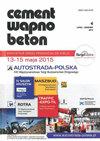Investigating the mechanical properties and durability indices of concrete containing Fe3O4/SiO2/GO and GO nanoparticles
IF 0.6
4区 工程技术
Q4 CONSTRUCTION & BUILDING TECHNOLOGY
引用次数: 0
Abstract
Recent research in the construction industry justifi es the partial replacement of cement by nanomaterials. Graphene oxide na-nocomposite is a material that has been recently proposed as a suitable alternative for part of cement in concrete. However, there is no research on the addition of these synthetic compounds to concrete, and little is known about the effect of these materials on the mechanical and durability properties of concrete. Therefore, in this laboratory study, the synthesis of Fe3O4/SiO2/GO and GO nanoparticles was performed and confi rmed with FT-IR, SEM, TEM analyses. These nanoparticles partially replaced cement by 1, 2, 3, and 4 % by mass of the cement, and their effect on mechanical and durability properties of concrete at the ages of 7, 28, and 90-day, were investigated. The results suggest that mixtures in which 2% Fe3O4/ SiO2/GO and 3% GO substituted cement yielded the best results in the mechanical properties tests. Concrete containing Fe3O4/SiO2/GO nanoparticles enhanced compressive strength by 14% and splitting tensile strength by 12% after 28-days of curing. Also, concrete containing 2% Fe3O4/SiO2/GO, had the highest re-sistance to an acidic environment, the lowest permeability, and the highest transient pulse velocity in the ultrasonic test, compared to the specimen containing GO nanoparticles and the control sample.研究了含Fe3O4/SiO2/GO和氧化石墨烯纳米颗粒混凝土的力学性能和耐久性指标
建筑行业最近的研究证明,纳米材料可以部分替代水泥。氧化石墨烯纳米复合材料是最近被提出的一种适合替代混凝土中部分水泥的材料。然而,目前还没有研究将这些合成化合物添加到混凝土中,对这些材料对混凝土力学性能和耐久性的影响也知之甚少。因此,在本实验室研究中,我们进行了Fe3O4/SiO2/GO和GO纳米颗粒的合成,并通过FT-IR, SEM, TEM分析进行了验证。研究了这些纳米颗粒分别以1、2、3和4%的水泥质量部分替代水泥,并研究了它们对混凝土在7、28和90天龄期的力学和耐久性性能的影响。结果表明,2% Fe3O4/ SiO2/GO和3% GO取代水泥的混合料在力学性能测试中取得了最好的效果。掺Fe3O4/SiO2/GO纳米颗粒的混凝土在养护28天后抗压强度提高14%,劈裂抗拉强度提高12%。此外,在超声波测试中,与含有氧化石墨烯纳米粒子的试样和对照试样相比,含2% Fe3O4/SiO2/GO的混凝土具有最高的抗酸性环境能力,最低的渗透率和最高的瞬态脉冲速度。
本文章由计算机程序翻译,如有差异,请以英文原文为准。
求助全文
约1分钟内获得全文
求助全文
来源期刊

Cement Wapno Beton
CONSTRUCTION & BUILDING TECHNOLOGY-MATERIALS SCIENCE, COMPOSITES
CiteScore
1.30
自引率
28.60%
发文量
0
审稿时长
>12 weeks
期刊介绍:
The Publisher of the scientific bimonthly of international circulation, entitled "Cement-Wapno-Beton" ["Cement-Lime-Concrete"], is the Fundacja Cement, Wapno, Beton [Foundation Cement, Lime, Concrete]. The periodical is dedicated to the issues concerning mineral setting materials and concrete. It is concerned with the publication of academic and research works from the field of chemistry and technology of building setting materials and concrete
 求助内容:
求助内容: 应助结果提醒方式:
应助结果提醒方式:


